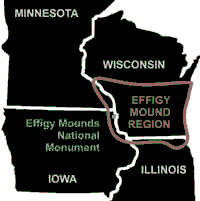Burial Mounds
Haga clic aquí para ver esta página en español.
Native Americans have lived in the area now called Wisconsin for more than 12,000 years. Throughout this time, Native Americans engaged in a near-universal practice of humans – the respectful disposition of their dead.
During the archaeologically defined Woodland period (between about 2,500 and 900 years ago), Native American earthwork or "mound" construction (generally associated with the burial of the dead) developed.
Wisconsin has a large number of such mounds, although many have been destroyed or otherwise affected by later development and natural processes. Prior to European colonization, there may have been more than 15,000 mounds in the State; perhaps 4,000 of these remain today.
Courtesy National Park Service.
The earliest mounds, dating to approximately 2,500 years ago, were round or "conical" in shape. Later, people built mounds in other forms as well, including linear-shaped and "effigy" mounds made in the shapes of animal/spiritual beings such as birds, turtles, bears, panthers and humanoid forms, among others. Still later, a small number of platforms or pyramidal mounds were constructed. Mounds sometimes exist singly but are more often part of groups of several to over 100 individual mounds. Wisconsin is the geological center of effigy mound distribution, with more effigy mound sites than anywhere else in the world.
In addition to building mounds during the Woodland period, Native Americans developed other technological innovations, including plant domestication, pottery and, late in the period, the bow and arrow.
Many burial mounds, as well as other burial sites (both Native American and non-Native American), are in state parks, forests, and other properties. All of these sites are protected from disturbance under the State's burial sites law (Wisconsin Statutes s.157.70), and no disturbance may take place near the perimeter or base of a mound or other defined burial area. Visitors should not walk over or picnic on burial mounds and other designated burial sites. State law (section 157.70, Wis. Stats. [exit DNR]) protects all such burial areas, including those on both public and private lands, against unauthorized disturbance.
Courtesy National Park Service.
Other mounds, such as platform mounds, are protected as burial mounds even though they serve different primary functions. Examples are those related to the Mississippian (not Woodland) culture of Aztalan. For example, the ceremonial mounds at Aztalan State Park were most likely used for ceremonies or lodging for high-ranking officials. There are very few such sites in Wisconsin, but Aztalan is important as the northern expression of a Mississippian period "empire," directly related to the great site of Cahokia, Illinois [exit DNR] (near St. Louis), a World Heritage Site [exit DNR].
The Department of Natural Resources (DNR) is the State's single largest caretaker of archeological sites, historic structures, and other important cultural resources, including burial areas. The DNR manages these important cultural resources – physical records of our common past – on behalf of the people of Wisconsin.
To learn more about Wisconsin's Native American nations and tribal communities, please see Tribal Nations of Wisconsin [exit DNR].



